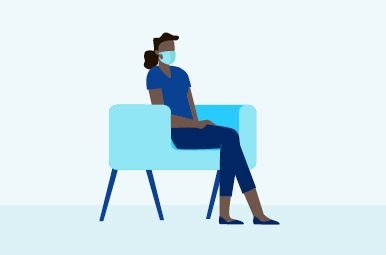This is a potentially anxiety producing period for all of us, made even worse by the plethora of information circulating on social media and other outlets.
It’s not about what’s right or wrong with how countries are handling the pandemic, because this is not a simple issue. There are so many shades of grey.
The situation is different depending on where you live, even down to the city and town level. Some states and countries are reopened; others are facing additional weeks of lockdown.
No matter the situation, it’s all about protection – protecting you and others.
It’s important as this crisis evolves that we focus on the facts, not opinion or supposition.
Here we highlight some facts and fictions about coronavirus and COVID-19.
- I’m young and healthy. I don’t have anything to worry about. It is true that you could be more likely to end up hospitalized if you are 60 or older and/or have underlying health conditions such as heart disease, diabetes, high blood pressure, and lung conditions like asthma and COPD.[1]
And it is also true that about 80 percent of people who become infected will have mild to moderate symptoms and won’t require hospitalization.[2] What we’re learning, however, is that the virus doesn’t discriminate based on age. Every person – no matter your age, gender, economic status, or overall health—could potentially be infected. In addition, data shows that one in five of those ages 20 to 44 who were infected still required hospitalization, with 2 to 4 percent winding up in the intensive care unit.[3]
You can read more about how the virus is affecting younger people here.[4]
- We’re all sheltering in place and people are wearing PPE, yet we’re hearing people are still getting sick and dying. What’s the point? The main point of sheltering and/or wearing PPE is to help flatten the curve, i.e., the number of people who become critically ill at the same time and overwhelm the health care system. While that same number of people may become ill and require hospitalization, if we can spread this out over time, the health care system may be able to keep up. Try to think of it a little like trying to turn a tsunami into a gentle wave.[5]
- I’ll just skip my mammogram this year. Not so fast. While most screening mammograms were put on hold, centers are reopening. [6]
Either way, it’s good to get your mammogram a few months late rather than skip it altogether. In fact, you could probably schedule your mammogram for a couple of months out now. Then you have it on your calendar. Set a reminder here.
At the same time, you can also conduct your own breast self-exam. Learn how here, and what signs to watch for if you feel anything unusual.
- I have breast cancer. What happens now? That depends on where you are in your treatment, how far your cancer has progressed, and even the type of cancer you have. You should consider speaking with your healthcare team to develop a plan that treats your cancer while minimizing your risk for serious infection. You can read more about cancer treatment during the COVID-19 outbreak here.[7]
- Life will be back to normal in a month. Actually, even when shelter-in-place restrictions are lifted, many experts don’t expect a quick return to “normal.”[8] We still have to be hyper-aware of the potential of another outbreak until we have a vaccine. That may require continued cancellations of large events and continued social distancing, including fewer diners in restaurants, curbside retail shopping, and wearing face masks in public.
- Thank goodness we’ll have a vaccine this summer. The reality is that there probably won’t be a vaccine until sometime in 2021.[9] Although several are already in early-stage clinical trials, testing a vaccine is more complex than testing a drug because it takes time for participants who receive the vaccine to develop immunity and to see if it works in a healthy population.[10]
Experts at Johns Hopkins predict an effective vaccine in about a year; [11] but production still has to be scaled up to vaccinate the entire world, which will take time. Health care workers and other front-line workers will likely be the first to be vaccinated. You can read more about the vaccine process here.
- I hear we have a good treatment for COVID. As of early May 2020, there was no approved treatment for COVID-19. The good news is that pharmaceutical companies and researchers around the world are bringing drugs into human trials in record time, with hundreds of clinical trials currently underway on dozens of potential treatments.[12]
- I can’t get COVID-19 if I wear a mask. The recommendation from health agencies like the CDC to wear a mask is to protect others in case you’re infected.[13] There is good evidence that you can be infected but not have any symptoms. While the cloth masks most people are wearing aren’t perfect, they will reduce the number of virus-containing respiratory droplets that get into the air. You have to be careful, though, not to touch your face when putting the mask on and taking it off.[14] You can read more about masks here.
- There’s nothing I can do about COVID-19. Not true at all! One important thing you can do is stay as healthy as possible and keep your immune system as healthy as possible. That means:[15],[16],[17]
- Quit using all tobacco products. COVID-19 attacks the lungs; you want yours as healthy as possible.
- Follow a healthy diet (ie, eat real, not processed, foods).
- Get regular exercise. It might be hard with the lockdowns, but regular walks, runs, bike rides, and body weight exercises are key.
- Maintain a healthy weight.
- If you drink alcohol, drink only in moderation.
- Get enough sleep (naps count!).
- Find ways to manage the stress. Meditation, deep breathing, journaling, coloring, and online therapy are all good options.
Take care!
[1] Centers for Disease Control and Prevention. People who need to take extra precautions. https://www.cdc.gov/coronavirus/2019-ncov/need-extra-precautions/index.html
[2] World Health Organization. Coronavirus disease 2019 (COVID-19)
Situation Report – 41. Available at: https://www.who.int/docs/default-source/coronaviruse/situation-reports/20200301-sitrep-41-covid-19.pdf?sfvrsn=6768306d_2
[3] Severe Outcomes Among Patients with Coronavirus Disease 2019 (COVID-19) — United States, February 12–March 16, 2020. MMWR Morb Mortal Wkly Rep 2020;69:343-346. DOI: http://dx.doi.org/10.15585/mmwr.mm6912e2external icon.
[4] Hundreds of young Americans have now been killed by the coronavirus, data shows. Washington Post. April 8, 2020. https://www.washingtonpost.com/health/2020/04/08/young-people-coronavirus-deaths/
[5] Social distancing works. The earlier the better, California and Washington data show. Washington Post.
April 1, 2020. https://www.washingtonpost.com/nation/2020/04/01/lockdown-coronavirus-california-data/
[6] Peninsula Breast Center Reopens for Screening Mammography on May 13. https://www.peninsula.org/news/peninsula-breast-center-reopens-screening-mammography-may-13.
[7] ASCO. COVID-19 Patient Care Information. Updated May 18, 2020. https://www.asco.org/asco-coronavirus-information/care-individuals-cancer-during-covid-19
[8] Castillejo E, Francis E. Fauci tells David Muir US return to normal will not be like a ‘light switch’ turned on. ABC News. April 16, 2020. https://abcnews.go.com/Health/fauci-tells-david-muir-us-return-normal-light/story?id=70164631
[9] United Nations COVID-19 Response. https://www.un.org/en/coronavirus/covid-19-faqs
[10] LaFave S. What Will It Take To Develop A Vaccine For COVID-19? Hub. Johns Hopkins University. March 26, 2020. Available at: https://hub.jhu.edu/2020/03/26/covid-19-vaccine-development-ruth-karron/
[11] LaFave S. What Will It Take To Develop A Vaccine For COVID-19? Hub. Johns Hopkins University. March 26, 2020. Available at: https://hub.jhu.edu/2020/03/26/covid-19-vaccine-development-ruth-karron/
[12] Clinicaltrials.gov. April 29, 2020. https://clinicaltrials.gov/ct2/results?cond=COVID-19&term=&type=Intr&rslt=&recrs=b&recrs=a&recrs=d&age_v=&gndr=&intr=&titles=&outc=&spons=&lead=&id=&cntry=&state=&city=&dist=&locn=&rsub=&strd_s=&strd_e=&prcd_s=&prcd_e=&sfpd_s=&sfpd_e=&rfpd_s=&rfpd_e=&lupd_s=&lupd_e=&sort=
[13] https://www.mayoclinic.org/diseases-conditions/coronavirus/in-depth/coronavirus-mask/art-20485449
https://www.cdc.gov/coronavirus/2019-ncov/prevent-getting-sick/prevention.html
[14] Berkowitz B, Steckelberg A. Answers to your DIY face mask questions, including what material you should use. Washington Post. April 9, 2020. https://www.washingtonpost.com/health/2020/04/07/answers-your-diy-face-mask-questions-including-what-material-you-should-use/?arc404=true
[15] COVID-19: Eating, moving and meditating are keys to staying healthy. March 24, 2020. https://newsnetwork.mayoclinic.org/discussion/covid-19-eating-moving-and-meditating-are-keys-to-staying-healthy/
[16] How to stay fit and healthy during coronavirus (COVID-19) Pandemic. April 19, 2020. https://nutrition.org/how-to-stay-fit-and-healthy-during-coronavirus-covid-19-pandemic/.
[17] https://www.who.int/news-room/campaigns/connecting-the-world-to-combat-coronavirus/healthyathome?gclid=EAIaIQobChMIgKXWgoXj6QIV1pTVCh3h-Q5yEAAYASAAEgJejPD_BwE




Leave a Reply